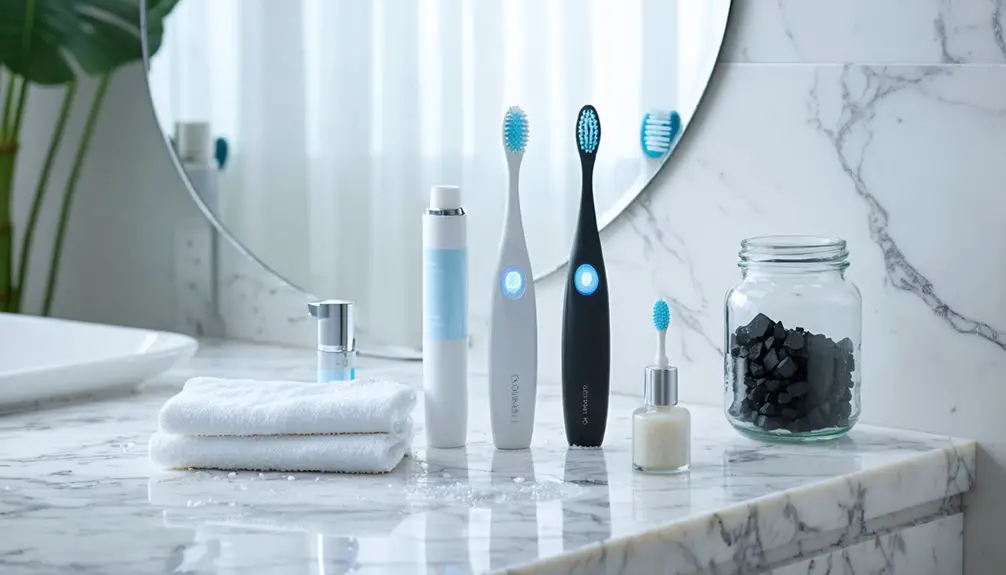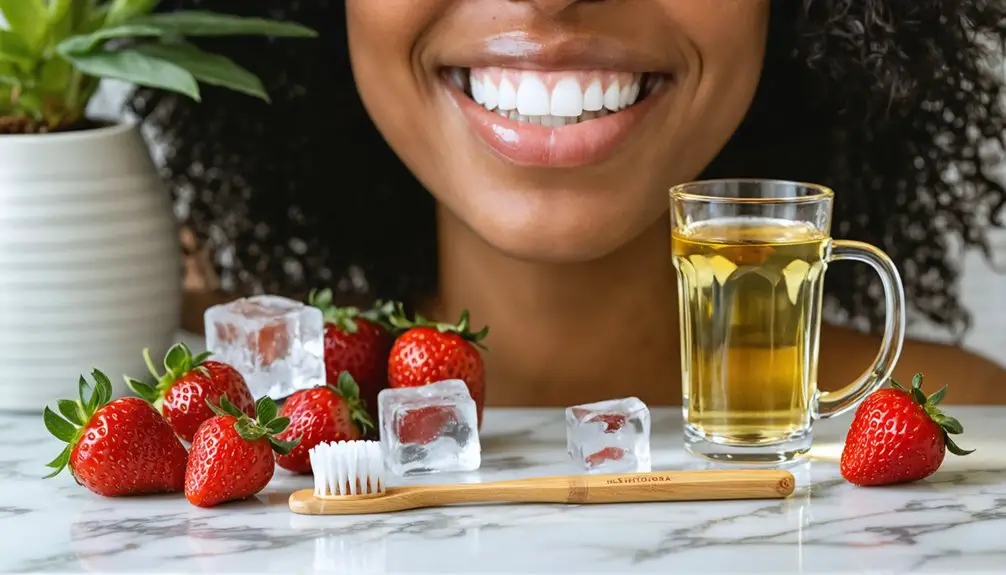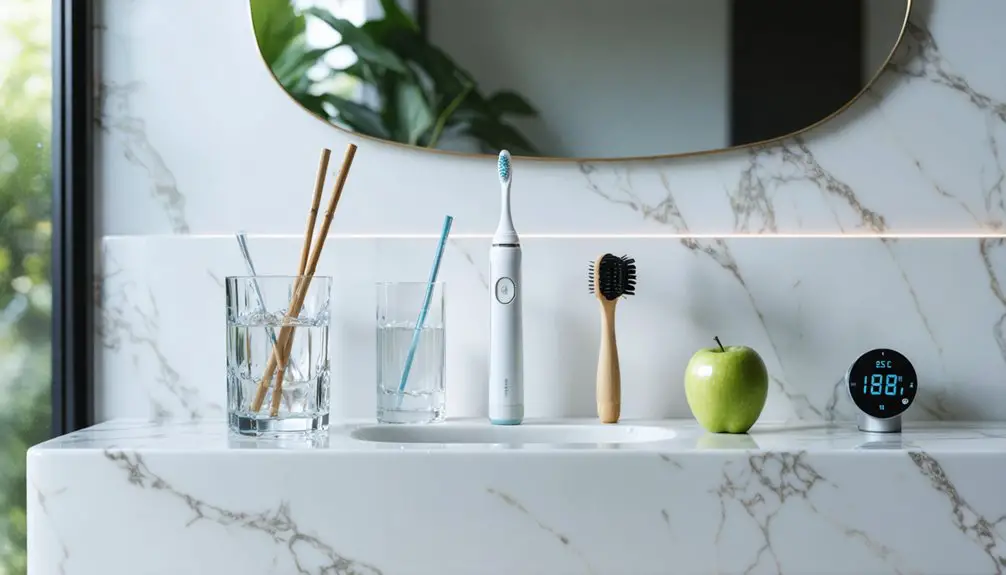For safe and effective home teeth whitening, choose ADA-approved products with 3-10% hydrogen peroxide or 10-35% carbamide peroxide. Apply whitening gel precisely using well-fitted trays, and limit treatments to once daily. Protect your enamel by avoiding acidic DIY remedies and using fluoride products before and after whitening. Wait 48 hours post-treatment before consuming staining beverages, and maintain results with proper oral hygiene. Our detailed guide offers proven techniques for professional-level results.
Key Takeaways
- Choose whitening products containing 3-10% hydrogen peroxide or 10-35% carbamide peroxide with the ADA Seal of Acceptance.
- Apply whitening gel sparingly using 1/4 to 1/5 cc per tray, focusing on front teeth and wiping excess from gums.
- Allow sufficient breaks between whitening treatments to protect enamel and use fluoride-based products for remineralization.
- Avoid staining beverages like coffee, tea, and red wine for 48 hours after treatment to maintain results.
- Maintain results through daily oral hygiene and schedule touch-up treatments every 6-12 months as needed.
Choosing Safe and Effective Whitening Products
When choosing teeth whitening products, understanding the key active ingredients and safety profiles is essential for achieving perfect results without compromising dental health.
Safe and effective teeth whitening starts with knowing the science behind key ingredients and selecting products with proven safety records.
Look for products containing hydrogen peroxide or carbamide peroxide at safe concentrations (3-10% and 10-35% respectively), or newer alternatives like phthalimidoperoxycaproic acid for gentle whitening. Custom-fit trays help ensure even coverage and minimize gum irritation during treatment.
In product comparisons, whitening strips and pre-filled trays typically offer better results than pens or toothpaste. Tests showed strips can whiten teeth by 2.7 shades in just two weeks.
Prioritize options with the ADA Seal of Acceptance and clear ingredient transparency. You’ll want to select products that include sensitivity-reducing compounds like potassium nitrate or fluoride.
For maximum safety, avoid treatments with extremely high peroxide concentrations unless supervised by a dental professional.
Consider LED-activated kits for accelerated results, but make sure they’re from reputable manufacturers with proven safety records.
Proper Application Methods for Best Results
To achieve ideal teeth whitening results, proper application techniques make all the difference in both safety and effectiveness.
Start with careful tray preparation by briefly submerging them in boiled water for 3-5 seconds, then trim them to fit precisely against your teeth surfaces. Always dry both trays and teeth thoroughly before proceeding. Using sensitive toothpaste before starting treatment can help minimize discomfort during the whitening process.
For best gel application, use approximately 1/4 to 1/5 cc of whitening gel per tray, applying a small drop to each tooth’s surface. Focus the gel on your front teeth, and don’t spread it across the entire tray. If any gel seeps onto your gums, quickly wipe it away.
Store your whitening gel in a cool place to maintain its potency, and clean your trays thoroughly after each use with cold water to prevent gel buildup. Limit yourself to once per day treatments to avoid excessive tooth sensitivity.
Preventing Enamel Damage During Whitening
Protecting your teeth’s enamel during whitening treatments requires a careful balance of product selection and application methods. Choose whitening products with lower peroxide concentrations and avoid abrasive ingredients that can wear down your enamel.
You’ll want to prioritize enamel safety by limiting whitening frequency to recommended intervals and using fluoride-based products before and after treatments. Professional treatments offer customized whitening plans that can better protect your enamel while achieving desired results.
Natural remedies like lemon juice and activated charcoal can cause permanent damage to your tooth enamel.
If you’re using at-home whitening kits, don’t exceed the recommended application times, and always allow break periods between treatments for enamel remineralization.
It’s crucial to maintain proper oral care without aggressive brushing, especially right after whitening sessions.
Consider consulting your dentist first, particularly if you have sensitive teeth or existing enamel concerns, as they can recommend the most suitable whitening protocol for your specific needs.
Post-Treatment Care and Sensitivity Management
After completing a teeth whitening treatment, proper post-care becomes essential for managing sensitivity and maintaining your results.
Following key post-treatment guidelines, you’ll need to avoid staining agents like coffee, tea, red wine, and dark sodas for at least 48 hours while your enamel remains porous. Use only clear or non-colored dental products during this period. Gentle alcohol-free mouthwash can provide safe rinsing during recovery.
For sensitivity relief, use desensitizing toothpaste and consider over-the-counter pain medications if needed. Brush gently with a soft-bristled toothbrush, and stick to non-staining, light-colored foods. Regular touch-up treatments may be necessary to maintain long-term whitening results.
You can chew sugarless gum to reduce peroxide levels in your mouth and help with discomfort. Remember to wait 30 minutes before brushing after consuming acidic foods, and rinse frequently with water throughout the day to protect your newly whitened smile.
Maintaining Your Brighter Smile Long-Term
Once you’ve achieved your desired level of whiteness, maintaining those brilliant results requires a thorough approach to oral care and lifestyle habits.
Make essential lifestyle adjustments by brushing twice daily with fluoride toothpaste, flossing regularly, and using whitening mouthwash. Monitor your dietary choices carefully, limiting consumption of staining beverages like coffee, tea, and red wine. Consistent touch-up treatments may be needed to maintain optimal whiteness every 6-12 months.
Replace your toothbrush every three months and schedule regular dental check-ups for professional maintenance. When consuming colored drinks, use a straw to minimize contact with your teeth. Consider using an electric toothbrush for more effective plaque removal.
Include crunchy fruits and vegetables in your diet to naturally clean tooth surfaces. Remember to rinse your mouth with water after meals, and avoid harmful habits like smoking that can quickly reverse your whitening results.
Frequently Asked Questions
Can I Whiten My Teeth While Wearing Braces or Dental Implants?
While 85% of orthodontists advise waiting, you can use gentle whitening toothpaste with braces. However, implants won’t whiten, so discuss braces whitening and implant safety with your dentist first.
How Long Should I Wait Between Professional Whitening and Home Whitening Treatments?
You’ll need to wait 6 months to 1 year between professional and home whitening treatments to protect your enamel. This whitening frequency reduces treatment sensitivity and prevents potential damage.
Will Whitening Treatments Affect the Bonding Material of My Dental Fillings?
While you’ll want whiter teeth, whitening treatments won’t change your bonding materials’ color. They’ll remain the same shade, potentially creating noticeable differences between your natural teeth and fillings after treatment.
Does Medication-Induced Tooth Discoloration Respond Differently to Whitening Treatments?
Yes, medication types affect whitening success differently. Intrinsic stains from tetracyclines are harder to treat than surface discoloration causes. You’ll need professional treatment and longer whitening protocols for ideal results.
Can Pregnant or Nursing Mothers Safely Use Teeth Whitening Products?
Like ancient wisdom says, you shouldn’t whiten teeth during pregnancy due to safety concerns. Wait until after delivery, or try alternative methods like natural stain prevention and proper oral hygiene while nursing.
References
- https://cheslynhaydental.co.uk/do-these-8-popular-home-teeth-whitening-methods-work/
- https://healthcare.utah.edu/the-scope/health-library/all/2023/10/does-home-teeth-whitening-really-work
- https://www.lwdentist.com/diy-teeth-whitening-what-works-and-what-to-avoid/
- https://pmc.ncbi.nlm.nih.gov/articles/PMC4058574/
- https://www.sandiegoartofdentistry.com/blog/what-is-the-best-teeth-whitening-method/
- https://www.goodhousekeeping.com/health-products/g28723133/best-at-home-teeth-whitening-products/
- https://g-p-dental.com/best-teeth-whitening-kits-in-2025-safe-option/
- https://nhdentistrybeverlyhills.com/press/6-of-the-best-teeth-whitening-kits-in-the-drugstore/
- https://www.goodrx.com/conditions/dental-care/is-teeth-whitening-safe
- https://restoredentalco.com/post-op/at-home-teeth-whitening-instructions-and-maintenance/



